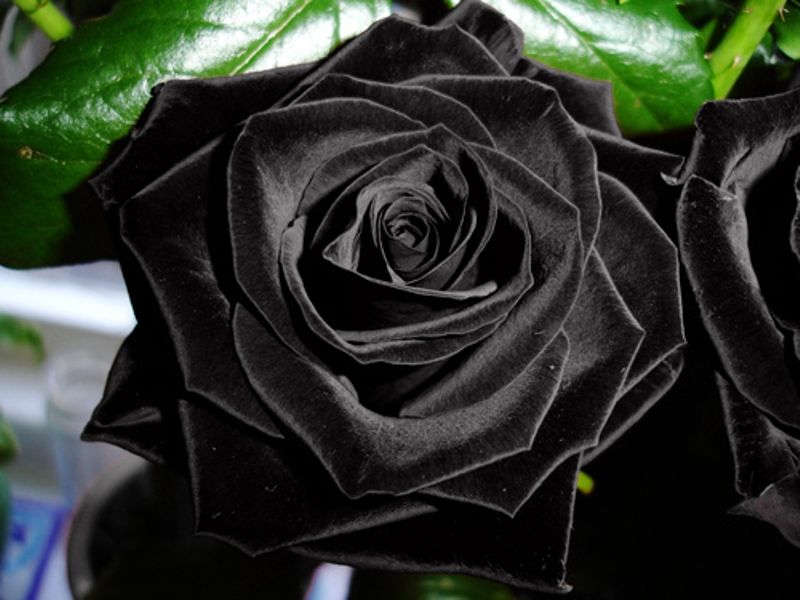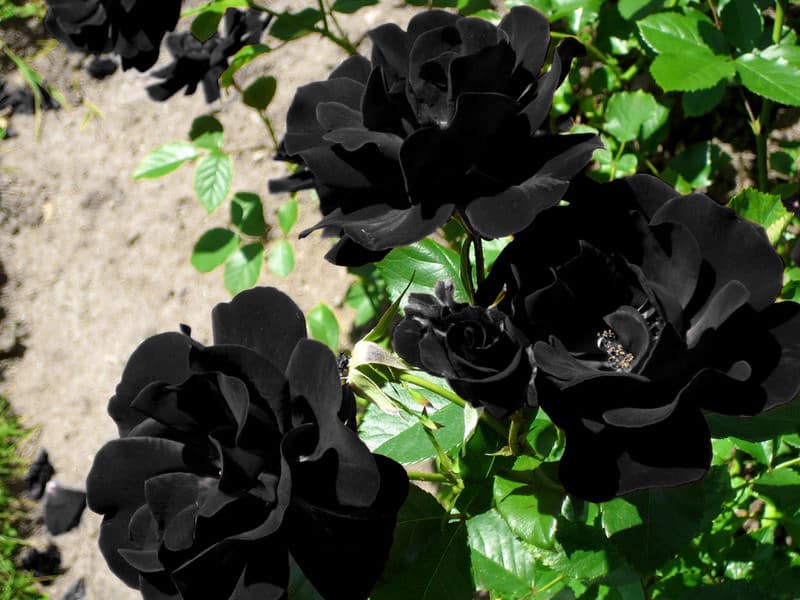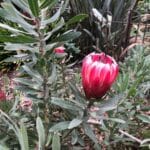Many of us are drawn to the color black, probably because of the mystery it emanates or its boldness that easily appeals to us.
When we learned that our favorite flower, the rose, now comes in the darkest of color, it became the talk of the town. We were drawn, we wanted to own one. Some even traveled to see the enigmatic blossom for themselves. But does the black rose really exist? Is it even real? Can you grow it naturally?
In this guide, you will learn about the story of the black rose and uncover the mystery surrounding this flower.

Origin and History
It was in 2013 when a video of the black rose that grew in Turkey went viral. This rare-colored flower, called ‘kara gul’ in Turkish, bloomed in Halfeti, a village near the historical Euphrates River. It was said that the flower bud starts out a deep shade of red and progresses to a rich, velvety black as the flower opens (1).
Incidentally, when the black rose of Halfeti is grown elsewhere, the emerging flower is a typical red rose. This is because the black hue is said to be the result of Halfeti’s unique soil pH brought about by the water from the Euphrates River.
The story sounds suspicious, especially since when one looks up the black rose of Halfeti online, most results show images of black roses looking heavily edited. And it doesn’t help that when further researched, it will be found that the village of Halfeti is actually now submerged in water due to flooding when a dam broke a couple of years ago. It is easy to deduce that the story may be a hoax, some consider a tourism marketing stunt.
Color Manipulation
Scientifically, black pigmentation in plants is extremely rare, if not impossible. In fact, this only exists in horticultural plant cultivars (2).
While the uniqueness of the color only adds to their allure, it’s worth noting that fresh-cut black roses aren’t genuinely black.
Black roses can only be produced by subjecting certain rose plants to breeding programs and propagation techniques but this does not even guarantee a perfectly-colored black rose.
Another method that can be employed is by applying a black dye to the rose flowers or plants. Let’s discuss about these 2 methods in details.
Breeding
Black roses have become popular in the floriculture industry. They serve as statements in floral bouquets and arrangements, both for weddings and Halloween. But these flowers only give the illusion that they are black.
These roses only exist in deep shades of red and purple cultivated by renowned breeders. The black rose varieties known today include ‘Black Bacarra’, ‘Black Jade’, ‘Black Beauty’, ‘Nigrette’, ‘Taboo’, and ‘Ebb Tide’ among others.
Black Baccara
Rosa ‘Black Baccara’ is a Hybrid Tea rose which resulted from crossing Rosa ‘Celica’ and Rosa ‘Fuego Negro’. It has velvety dark red flowers, the closest to black rose flowers can get. The inner side of the flower’s petals is red due to the pigment, pelargonin, and the outer petals are dark because of the blue pigment, cyanin (3).
The flowers are unscented but the long-lasting, catchy blossoms and long stems are what make them perfect as cut flowers.
Black Jade
Rosa ‘Black Jade’ belongs to the miniature roses which are impeccable as potted indoor plants or as borders in landscapes. The plant, introduced to the US in 1985 by Frank Benardella, is characterized by its small dark red flowers, glossy dark green leaves, and bushy growth habit (4).
Black Beauty
Rosa ‘Black Beauty’ is also a Hybrid Tea rose that grows up to a meter in height. The lightly scented flowers, discovered by W. Kordes in 1998, have dark crimson petals with almost black tips and although the blossoms are smaller and grow in clusters, they are preferred as cut flowers.
Nigrette
Rosa ‘Nigrette’, a Hybrid Tea rose, has burgundy flowers with loose petals. The flowers are very fragrant and bloom in early summer. Hybridized in 1934 by Max Krause, the plant grows as a shrub of up to a meter in height and blooms repeatedly (4).
Taboo
Rosa ‘Taboo’ otherwise known as ‘Grand Chateau’ was hybridized by Evers and Tantau in 1988. Belonging to the Hybrid Tea class of roses, the plant grows 2 meters tall. The flowers are richly fragrant and come in deep velvety red color (4).
Ebb Tide
Rosa ‘Ebb Tide’ is a Floribunda rose cultivated by Tom Carruth in 2001. The scented flower is unique, starts out mauve in color and fades into dark purple as it blooms. The blossoms grow in clusters on a shrub that can reach up to 2 meters in height (4).
Breeding these rose plants helped produce attractive flowers with long-lasting and natural-looking dark color. But it takes years and expertise to breed and produce the best black roses and many people are not equipped for this that’s why several techniques have been developed to turn rose flower’s color into black.
Light is a major dictator of a blossom color. In a study, petal blackening was observed when the flower buds, specifically of Rosa ‘Mercedes’, were covered with aluminum foil during the night at temperatures lower than 18°C (5).
See more: How to plant roses
Dyeing
Another method is the application of dye or food coloring and expert florists have mastered the procedures that they can even achieve an opaque black-colored rose! Some techniques can be quite easy that even amateurs can dye their flowers at home (6).
Floral Spray
Floral spray is one way of instantly changing the rose color. Aside from black, floral sprays also come in metallic colors of silver and gold and are applied using airbrushes. Most spray paints tend to be heavy but floral sprays are moderate in concentration and will not harm the delicate flowers.
Dip Dye
Dip dyeing is also a common technique wherein the flower heads are dipped in a mixture of water and food coloring. The flowers are then hanged to dry resulting in a rich black color.
Dye Absorption
Another common and easy technique is the absorption method. A vase is filled with the water-dye mixture and the freshly cut stems of roses are submerged in it. The dye-stained water will be absorbed by the stem through capillary action to the petals thus coloring them black. Leaving the flowers in this set up overnight will result in more color opaque petals.
While most of the known black rose varieties are commercially available, dyed black roses can be bought in any floral shops. DIY tutorials on dyeing flowers are also available on the internet which can be quite accessible to enthusiasts.
Some institutions offer rather expensive preserved black roses that are true to life in color. These flowers are preserved and colored via a conditioned alcohol-based system that can enable them to maintain their fragrance and to last for months, even years (7).
Black Rose Meaning and Symbolism

What does it mean when someone gives you a black rose flower bouquet?
Red roses are undoubtedly the most popular to gift loved ones since they represent love and romance, but black roses also have major value in relationships. In relationships, the black rose symbolism is often associated with mystery, intrigue, and unconventional love.
The black rose gained popularity in the nineteenth century during the Victorian Era due to literature and the Language of Flowers, in which most people communicated using flowers with coded messages. The dark flower has long been associated with black magic mutiny and resistance among anarchist and antiauthoritarian movements.
The black rose was first associated with a special significance in Ancient Greece and Ancient Rome, which makes sense given their Mediterranean location. Black roses were associated with masculinity and strength in these ancient societies.
Additionally, black roses are widely utilized in pop culture (songs, movies, literature, and so on) to represent tragedy, hatred, or sinister ideas from a jilted lover.
It also became a symbol of the Nazis during WWII as they ripped an opposing group, the White Rose.
They can nevertheless represent death, although in a more compassionate and less ominous way.
On a lighter note, their symbolic meaning has evolved to include the theme of new beginnings. The prospect of this new journey brings courage and hope.
The pursuit of the true black rose still continues and people’s dedication to this made the black rose a symbol of pure devotion (8).
When You Should Give Black Roses?
The symbolism of a single black rose might vary depending on the circumstance and the person giving or receiving it. The decision to give someone black roses should be carefully considered, as their symbolism is often associated with mystery, farewell, or tragic romance.
Here are some situations where black roses might be a perfect choice:
Mysterious Occasions: Consider these black flowers as the perfect gift on occasions that involve an element of mystery or intrigue, such as a surprise date or a mysterious event.
Endings or Closure: Black roses may be appropriate when expressing feelings of farewell or closure in a relationship. It could symbolize the end of a chapter or the completion of a significant phase.
Unconventional Relationships: If you and your partner share a unique or unconventional connection that defies traditional norms, black roses can be a symbolic gesture to celebrate the distinctiveness of your relationship.
Artistic Expression: Black roses can also be given as part of a creative or visual representation, such as during a themed event or if the recipient has a particular affinity for dark aesthetics.
A black rose flower arrangement can be given for a happy occasion such as a new career, a gold wedding anniversary, a new house, or other celebrations. Using solely a black rose for this type of arrangement may appear too bleak, so consider complementing it with gold.
FAQs
Why are black roses special?
Black roses are special due to their rarity, unique aesthetic appeal, and the symbolism associated with their dark color, representing mystery, the new beginning, and obsessive love. Their distinctiveness sets them apart as a striking and memorable floral choice and leaves a lasting impression.
What does the black forever rose mean?
A black forever rose is often symbolic of enduring mystery and eternal love. Its dark hue suggests a commitment that surpasses traditional boundaries, making it a unique and symbolic expression of lasting affection.
Is black rose good or bad?
The symbolism of a black rose is subjective; it can convey mystery, uniqueness, and elegance, but in some contexts, it may be associated with mourning or farewells, implying an ending or loss. The interpretation depends on the perspectives of various cultures and the intent behind the gesture.
Did you enjoy reading this article? Don’t forget to also check our A-Z List of Rose Names and Classifications with Pictures!
References
Reference List:
(1) Kandur, J.L. “The black rose of Halfeti.” Daily Sabah. 2015. https://www.dailysabah.com/feature/2015/07/24/the-black-rose-of-halfeti
(2) Hatier, J.B., et al. “The functional significance of black-pigmented leaves: photosynthesis, photoprotection and productivity in Ophiopogon planiscapus ‘Nigrescens’.” PloS one vol. 8,6 e67850. 24 Jun. 2013. Link
(3) Biran, I. et.al. “Factors determining petal color of Bacarra Roses III: effect of the ratio between cyanin and pelargonin.” Journal of Experimental Botany vol. 5 no. 1974. Pp. 632-637. link
(4) “Plants Database.” National Gardening Association. 2019. Retrieved from https://garden.org.
(5) Mor, Y. and Zieslin, N. “UV induced blackening of rose petals.” Environmental and Experimental Botany, vol.30 no. 1990. Pp.455-462. link
(6) Wyman, D. “Wyman’s gardening encyclopedia.” Simon and Schuster. 1986. P. 1221.
(7) Hayashi, T. et.al. “Protocol for preparing preserved flowers with natural color and texture.” Agris FAO. Vol. 20 No. 2. 2013. Pp. 445-448.
(8) Daphne and Cloe. “Language and meaning of flowers.” Edizioni REI. 2015. P. 134.
Feature image credit: dailysabah.com
Close






